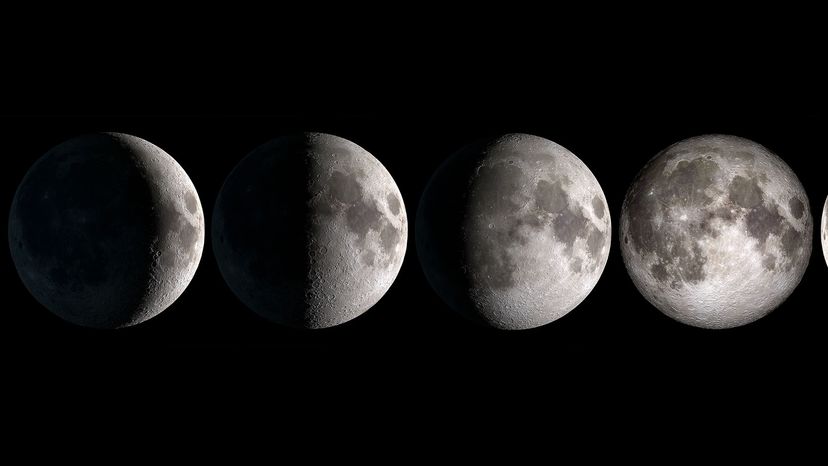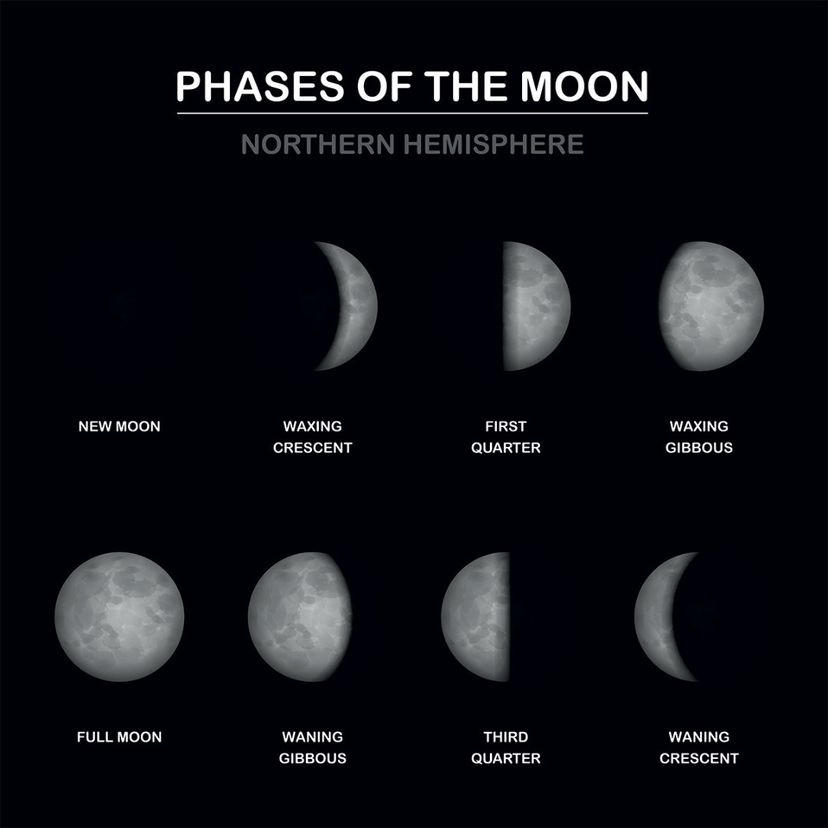By: Valerie Stimac|Updated: Jul 26, 2023

It's hard to imagine life on Earth without the moon overhead each night. Though the moon seems an omnipresent object in the night sky, it actually goes through a number of phases and has a unique set of steps in the celestial dance of our solar system.
If you've ever wondered why the moon looks different each night, rises at a different time, or what those strange names for the phases of the moon mean, the truth is out there. We'll explain the different moon phases and how the lunar cycle works — for our moon anyway (each moon is different on other planets!).
Advertisem*nt
Contents
- Why Does the Moon Have Phases?
- The Four Primary Moon Phases
- New Moon
- Waxing Crescent Moon
- First Quarter Moon
- Waxing Gibbous Moon
- Full Moon
- Waning Gibbous Moon
- Third Quarter Moon
- Waning Crescent Moon
Why Does the Moon Have Phases?
As we know, Earth's orbit revolves around the sun and the moon orbits Earth. The moon is "tidally locked," meaning the moon is rotating on its own axis at the same rate it orbits Earth (unlike Earth, which rotates at a different rate than it orbits the sun, hence we have both days and years). The tidal lock means the same hemisphere of the moon is always pointing at or visible from Earth.
The moon doesn't produce any light of its own — it just reflects the sun. The sun shines on different parts of the moon, since the same part of the moon is always facing us. Sometimes, we can see part of the moon that is illuminated by the sun (or all, such as during a full moon), and other times we cannot (during a new moon). Each night, a different amount of the moon is illuminated, which creates different phases of the moon.
Advertisem*nt
The Four Primary Moon Phases
The moon has eight phases in each lunar cycle: four primary phases and four secondary phases. The four primary phases are:
- new moon
- first quarter
- full moon
- third quarter
These occur at a specific time each month, and you can check the exact time to see if the moon will be risen and visible in your location as it reaches that phase.
Advertisem*nt
The Four Secondary Moon Phases
The four secondary moon phases are not at a specific time; they are transitions that the moon goes through between the primary phases. The moon may stay in one of these phases for seven days. They are:
- waxing crescent
- waxing gibbous
- waning gibbous
- waning crescent
For the most part, the names of the moon phases make sense, such as "waxing" when the illuminated part of the moon is growing and "waning" when the illuminated part is shrinking. The "crescent" moon is also a familiar concept, as the moon's shape is that of a crescent during this time. Perhaps the most novel term in the lunar calendar is "gibbous," which broadly means convex, but in astronomy specifically refers to the time when the moon is more than half but not wholly illuminated.
Let's look at an entire lunar cycle by going into detail about the lunar phases.

Advertisem*nt
New Moon
If you've ever looked up at night and not seen the moon, it might be due to the fact that we're in the new moon phase. At the moment of the new moon, the side of the moon facing Earth is not being illuminated by the sun, so it appears black — though to our eyes, it's doesn't actually "appear" at all and is not visible at all against the blackness of space beyond.
Advertisem*nt
Waxing Crescent Moon
The waning crescent phase of the lunar cycle occurs between the time of the new moon and when it reaches its first quarter phase. During this time, the moon appears as sliver in the night sky, growing more illuminated each night until half of it is lit (the first quarter phase). These first few days of the lunar cycle are also good for stargazing as the moon is still quite dim in the sky.
Advertisem*nt
First Quarter Moon
The first quarter phase of the moon is so named because it occurs when the moon is one-quarter of the way through its 29.5-day cycle. If you can see the moon on this night, it will appear half illuminated and half dark. (If you look at the sky, you might say there is a half-moon out.) As the moon passes through its first quarter phase, it begins to interfere with stargazing prospects and most avid stargazers will either switch to examining the moon directly or take a break from stargazing until later in the lunar cycle when the moon is less illuminated.
Advertisem*nt
Waxing Gibbous Moon
After passing through the first quarter phase, the moon continues to become more illuminated; in the waxing gibbous phase, it is not quite fully lit — but increasingly so. This phase takes about one week and offers great opportunities to use a telescope or binoculars to study the moon's terminator line where the light and dark parts of the moon meet.
Advertisem*nt
Full Moon
The full moon phase occurs on the night when the hemisphere of the moon facing Earth is completely illuminated by the sun. Most of us are familiar with this sight and perhaps even drew the full moon with a face as a child. While there is no "man in the moon," there are a number of fascinating craters and mare (basaltic plains formed from volcanic activity in the moon's past) that look like various shapes on the moon's surface.
Advertisem*nt
Waning Gibbous Moon
After passing through its full phase, the illuminated portion of the moon begins to decrease, which is the waning half of the lunar cycle. First, the waning gibbous phase occurs where the moon is not fully but still more than half illuminated.
Advertisem*nt
Third Quarter Moon
The final primary phase in the lunar cycle is the third quarter moon, which the moon reaches at a specific time each month. At this time, the "other half" of the moon will be illuminated, compared to the first quarter phase. However, you may not see the exact third quarter moon every month as it may not be visible during the day depending on where you live.
Advertisem*nt
Waning Crescent Moon
To end the lunar cycle, the moon moves through a waning crescent phase; like the waxing crescent, the moon looks like a curved sliver as it becomes increasingly less illuminated approaching the new moon and beginning of the next lunar cycle.
Now That's Interesting
While most people consider the moon to have a 28-day lunar cycle, the time between new moons is actually about 29.5 days long. This is called a synodic month and explains why the moon phases don't occur on the same day of each month. Interestingly, the moon takes a different length of time to orbit Earth (27 days, seven hours and 43 minutes), which is called a sidereal month. This why the moon rises at different times of the night each evening.
Cite This!
Please copy/paste the following text to properly cite this HowStuffWorks.com article:
Citation
Learn More About the Moon
Advertisem*nt
Advertisem*nt
Loading...
\n\n\t\t\t\t
`;t.byline_authors_html&&(e+=`By: ${t.byline_authors_html}`),t.byline_authors_html&&t.byline_date_html&&(e+="|"),t.byline_date_html&&(e+=t.byline_date_html);var i=t.body_html.replaceAll('"pt','"pt'+t.id+"_");return e+=`\n\t\t\t\t
\n\t\t\t\t
\n\n\t\t\t\t
${i=i.replaceAll("#pt","#pt"+t.id+"_")}
\n\n\t\t\t
`}(a);this.loadedDiv.innerHTML+=n,document.title=a.title+" | HowStuffWorks";let s="content-loaded-"+a.id,l=document.getElementById(s);l.dataset.contentId=a.id;let o=l.querySelectorAll(".lazyload");HSW.utilities.lazyLoadElements(o),HSW.ux.editorial.init({twitter:!0,facebook:!0,instagram:!0}),l.querySelectorAll(".toc a").forEach(t=>{t.addEventListener("click",t=>{t.preventDefault();let e=t.target.dataset.target,i=document.querySelector("a[name='"+e+"']");i?i.scrollIntoView({behavior:"auto"}):console.error("Unable to locate target with name "+e)})});try{if(userData.adsActive)if(HSW.utilities.isMobile()){l.querySelectorAll(".ad-mobinline").forEach(t=>{t.setAttribute("id","ad-wrap-mobinline"+r),t.childNodes[0].setAttribute("id","ad-div-mobinline"+r),void 0!==HSW.ads&&HSW.pq.add(()=>{HSW.ads.addNewUnits(["ad-div-mobinline"+r])},"ads"),r++})}else{let t=document.createElement("div");t.setAttribute("id","ad-after-"+e),t.classList.add("ad-inline","mb-8","bg-gray","w-max-full","h-min-90","text-center");let a=document.createElement("div");a.setAttribute("id","ad-div-inline"+i),t.appendChild(a),l.after(t),void 0!==HSW.ads&&HSW.pq.add(()=>{HSW.ads.addNewUnits(["ad-div-inline"+i])},"ads")}}catch(t){console.error(t)}if(window.setupSinglePageUX(l),history.pushState)try{history.pushState(null,a.title+" | HowStuffWorks",a.href)}catch(t){console.warn(t)}var c=[];a.taxonomy.forEach((t,e)=>{c[e]=t.title.toLowerCase()});var d=c.join("/"),h=[];a.authors.forEach((t,e)=>{h[e]=t.first_name.toLowerCase()+" "+t.last_name.toLowerCase()});var g=h.join(",");pageMetricsData.href=a.href,pageMetricsData.title=a.title,pageMetricsData.tax=d,pageMetricsData.aType=a.asset_type,pageMetricsData.cType=a.type+"-continuous",pageMetricsData.template=a.template,pageMetricsData.source=a.source,pageMetricsData.sponsor=a.sponsor,pageMetricsData.author=g,pageMetricsData.contentid=a.id,pageMetricsData.image=a.hero_image,pageMetricsData.page=0,pageMetricsData.pubDate=a.publish_date.slice(0,10),pageMetricsData.editDate=a.last_editorial_date.slice(0,10);const u=/[^\da-z_]/i;let p=HSW.utilities.isMobile()?"hsw_lite":"hsw";a.taxonomy.slice(1,3).forEach((t,e)=>{p+="|"+t.title.replace(u,"").toLowerCase()}),pageMetricsData.adUnit=p,Alpine.store("share",{title:pageMetricsData.title,url:pageMetricsData.href,image:pageMetricsData.image}),function(t,e){let i=t.href.split(".com/").pop();dataLayer.push({event:"virtual-page-view",virtualPageUrl:i,virtualPageTitle:document.title,pageNbr:0}),dataLayer.push({event:"raw-event-interactive",eventCategory:"page-interaction",eventAction:"continuous-load",eventLabel:"new-content",eventValue:e+1,virtualPageUrl:t.href})}(a,this.items.length);const m={...pageMetricsData};t.items.push(m);for(var f=document.getElementsByClassName("new-content-loaded"),v=0;v